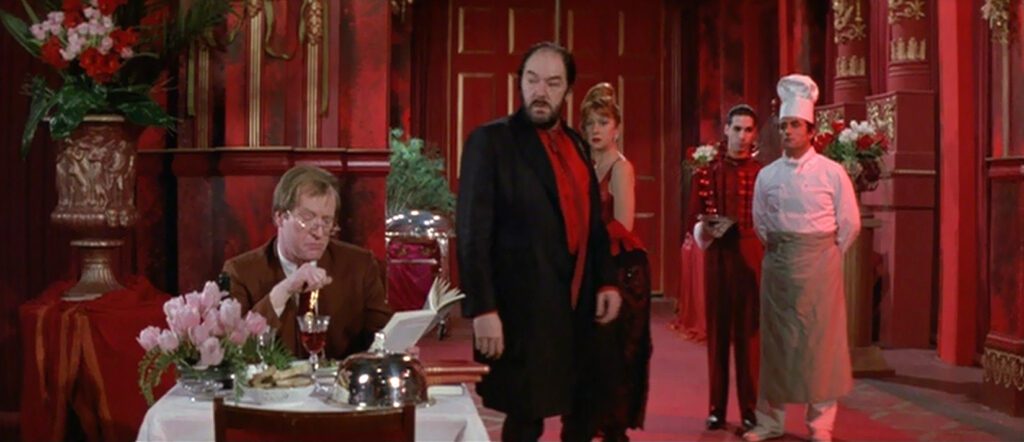
The Cook the Thief His Wife & Her Lover
1989, directed by Peter Greenaway
The most tangible consensus on The Cook the Thief His Wife and Her Lover is that it’s an allegory of Margaret Thatcher’s economy, of a free market society taken to an undesirable extreme where consumption is the supreme goal, and unchecked commerce dominates life to the point of tyranny – if not at present, then at least in a foreseeable dystopian future. This is probably a fair description, but it’s all too common for critics to mention allegory without spelling out the elements and relationships that make it more than a simple metaphor.
There are many obvious ways to cut and dice the film. It’s divided into distinct days of the week, each introduced by that day’s menu. There are four main characters linked to four main locations, each with its own dominant color, plus a couple of secondary locations apart from Albert’s restaurant. If the film has much to say about the power relations of an economic system then this abundance of symmetry must be more than the eccentric compulsion of a director interested in architecture and structure.
For starters, each of the color-coded spaces corresponds to a particular era of history:
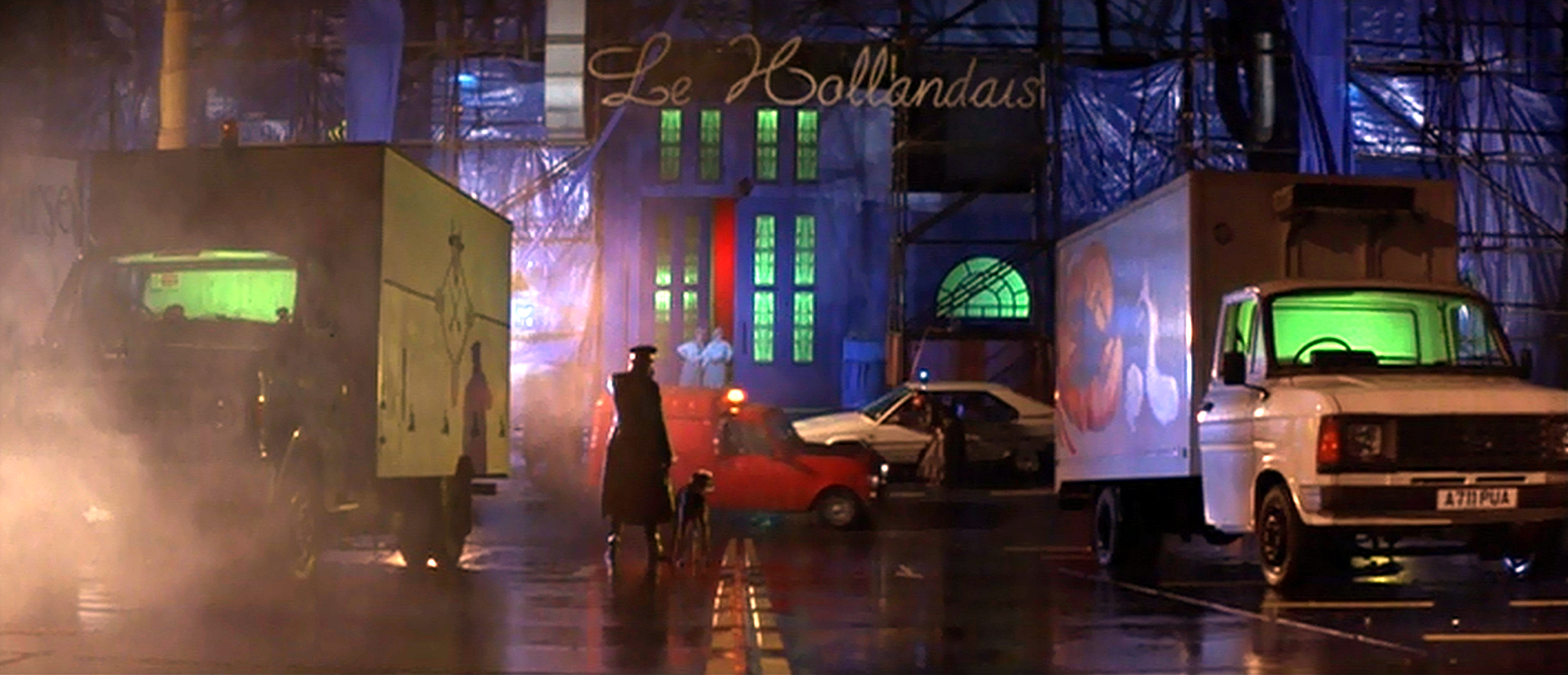
- The parking lot, ironically the one space unique to the modern world, is primeval. The other spaces are given to leading characters, but this is the realm of the dogs. It’s dark and violent, with steam, fire, rotting meat, and excrement. Its key color is blue.
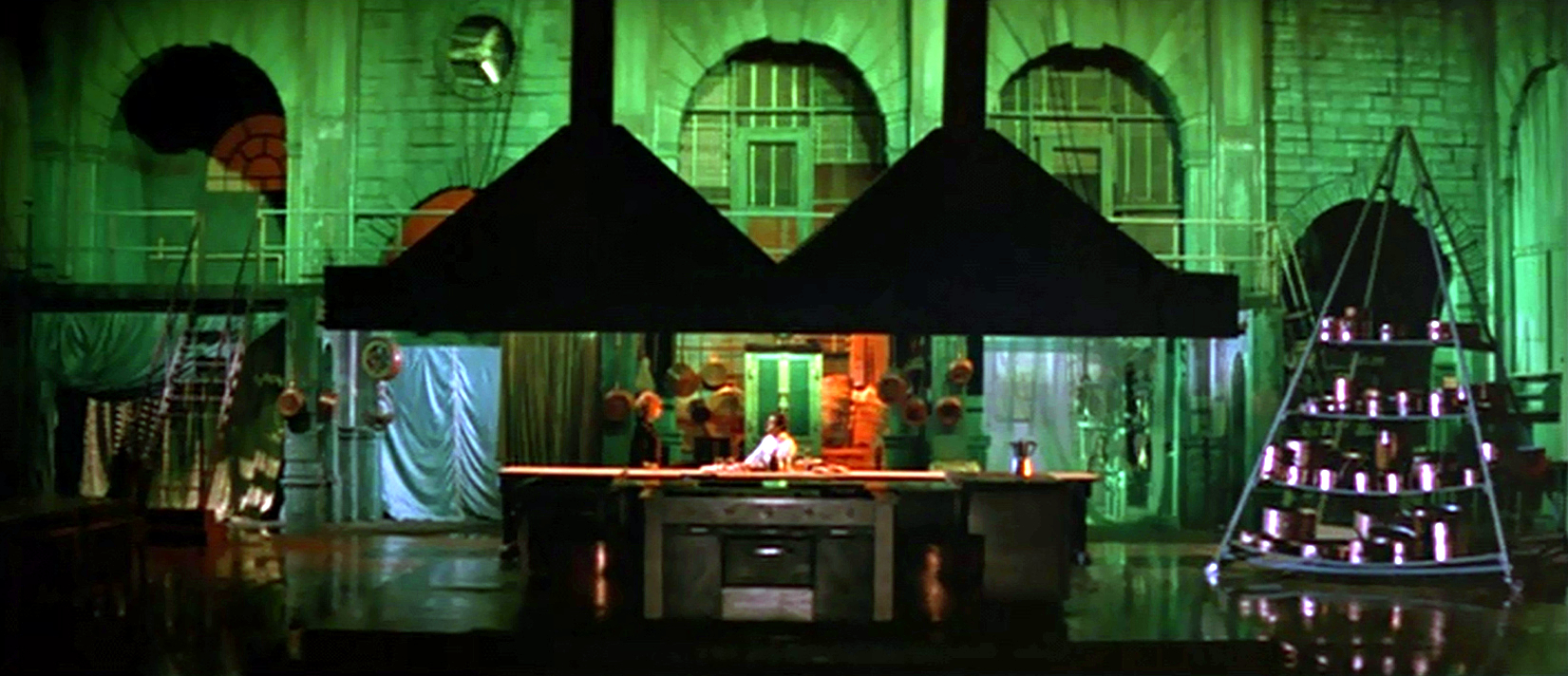
- The kitchen is the cook’s realm, dominated by green, and it evokes the Middle Ages. It’s dark like the lot outside, it’s a cavernous space with large arches, and it’s filled with the religious tones of the choirboy dishwasher’s Miserere. The kitchen staff are like the medieval artisans who would develop into the modern bourgeoisie.
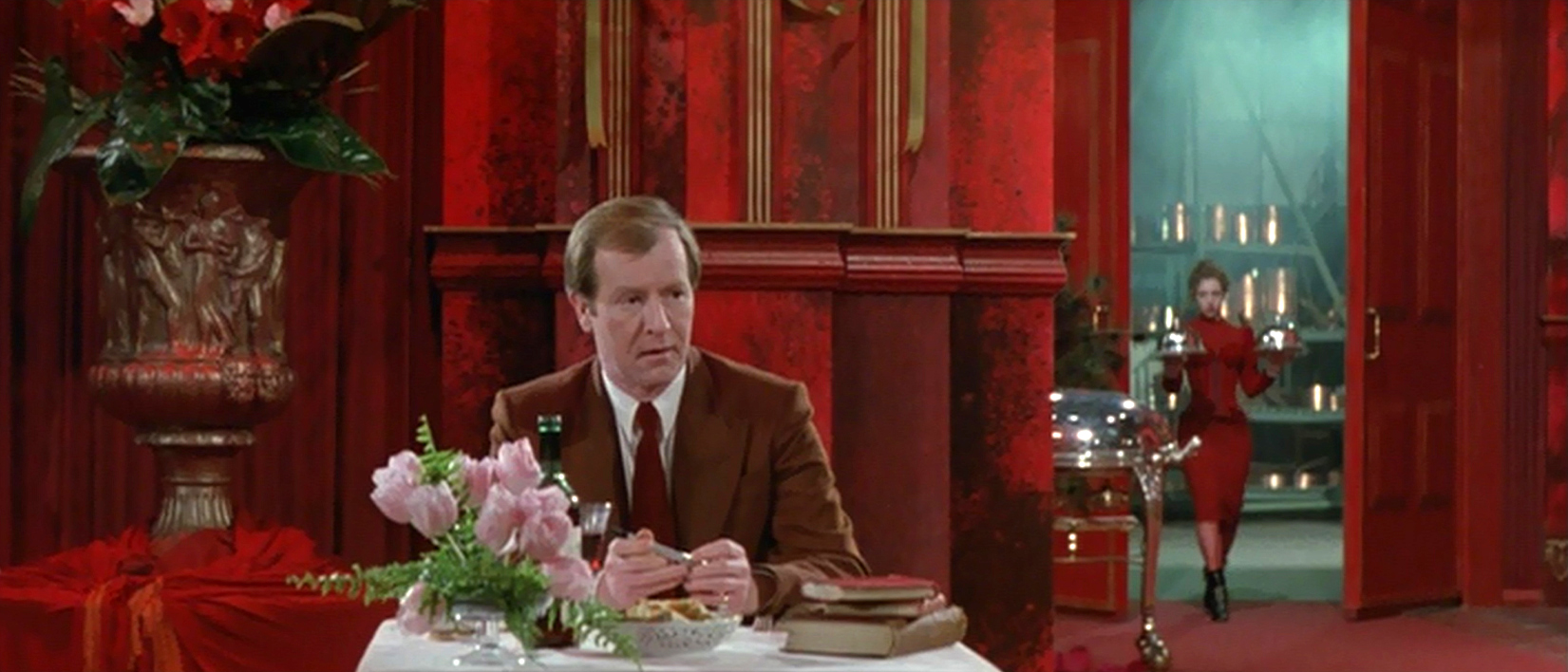
- The dining room is red and belongs to the gangster Albert Spica. Its centerpiece, a wall-sized reproduction of Frans Hals’ The Banquet of the Officers of the St George Militia Company in 1616, links it squarely with the 17th century.
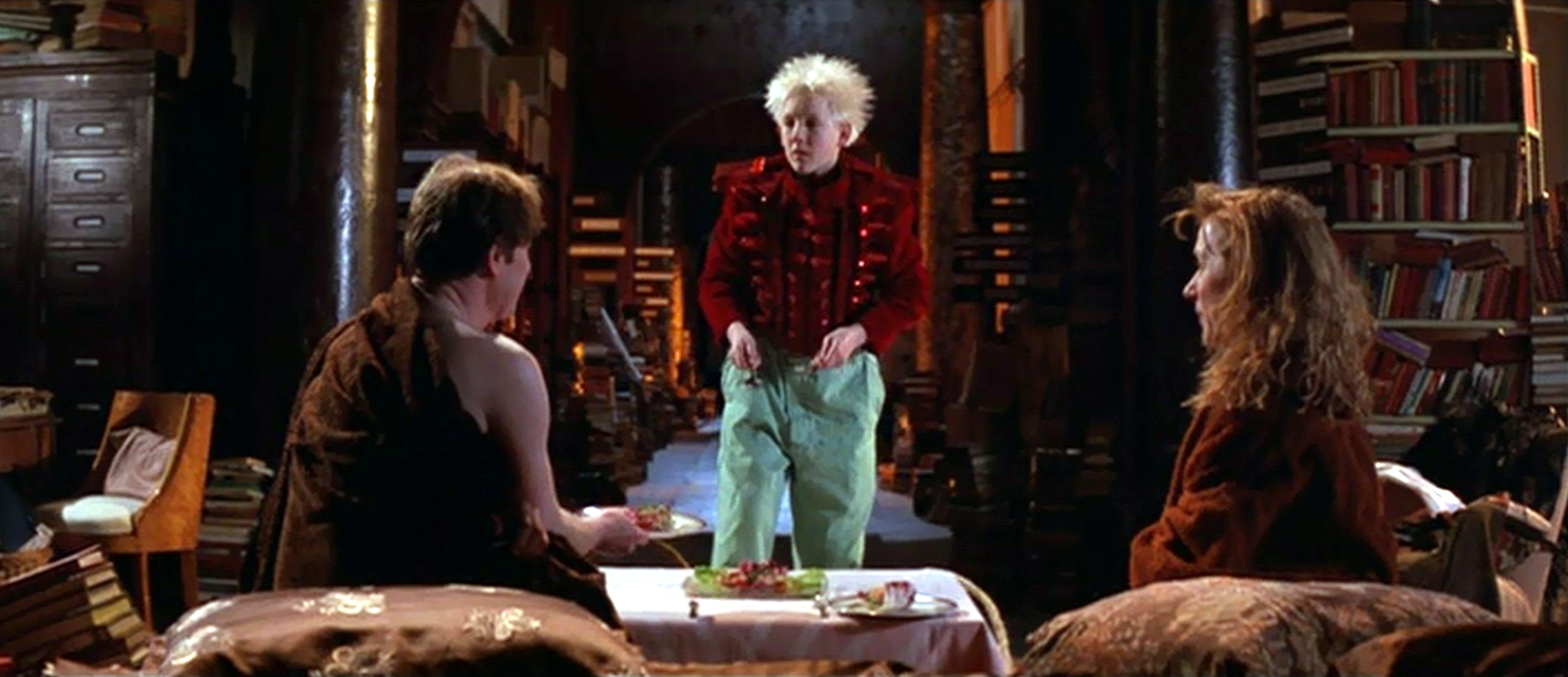
- The book depository, whose color ranges from vermilion to brown, is Michael’s territory and is most closely tied to the 18th century with its collection of books on the French Revolution.
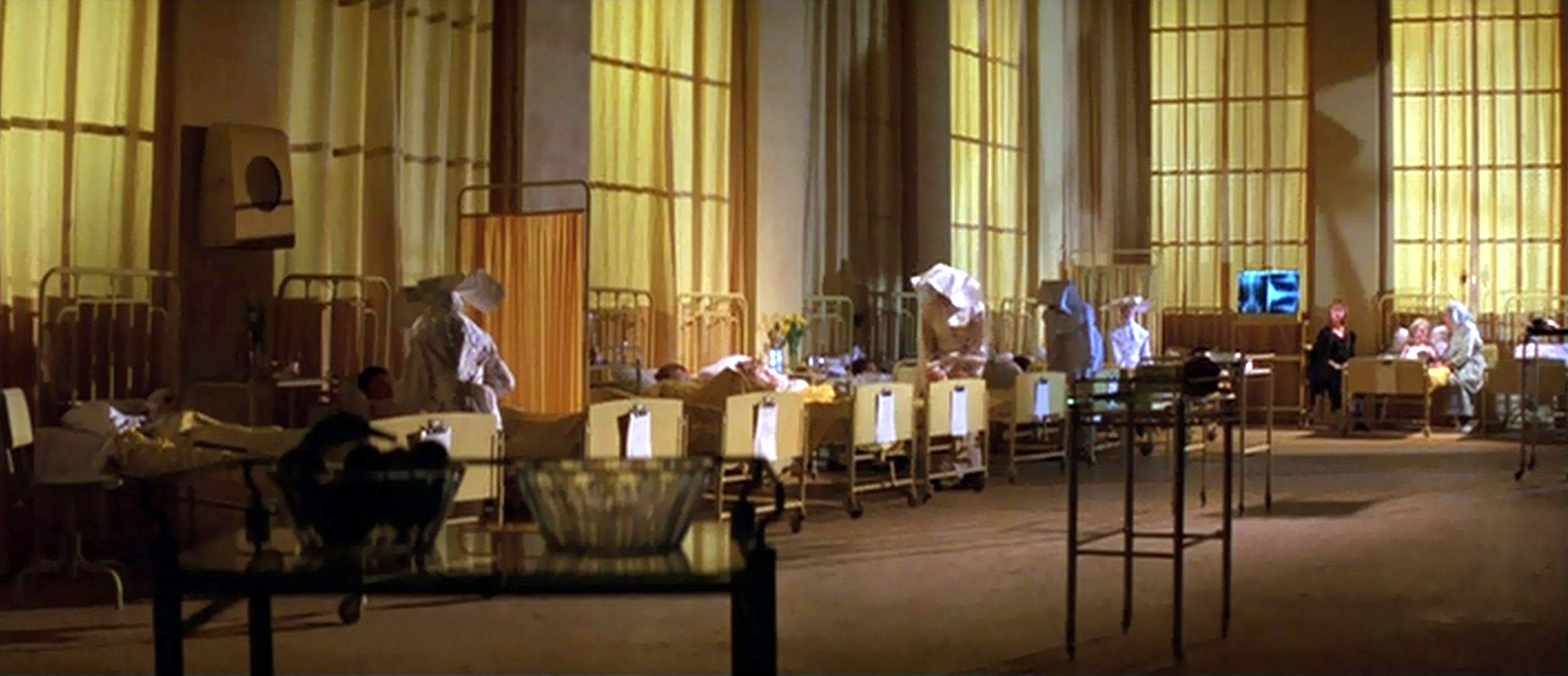
- The hospital, which appears only briefly, is yellow and belongs to the nuns who nurse Pup and other patients. It vaguely evokes the 19th century.
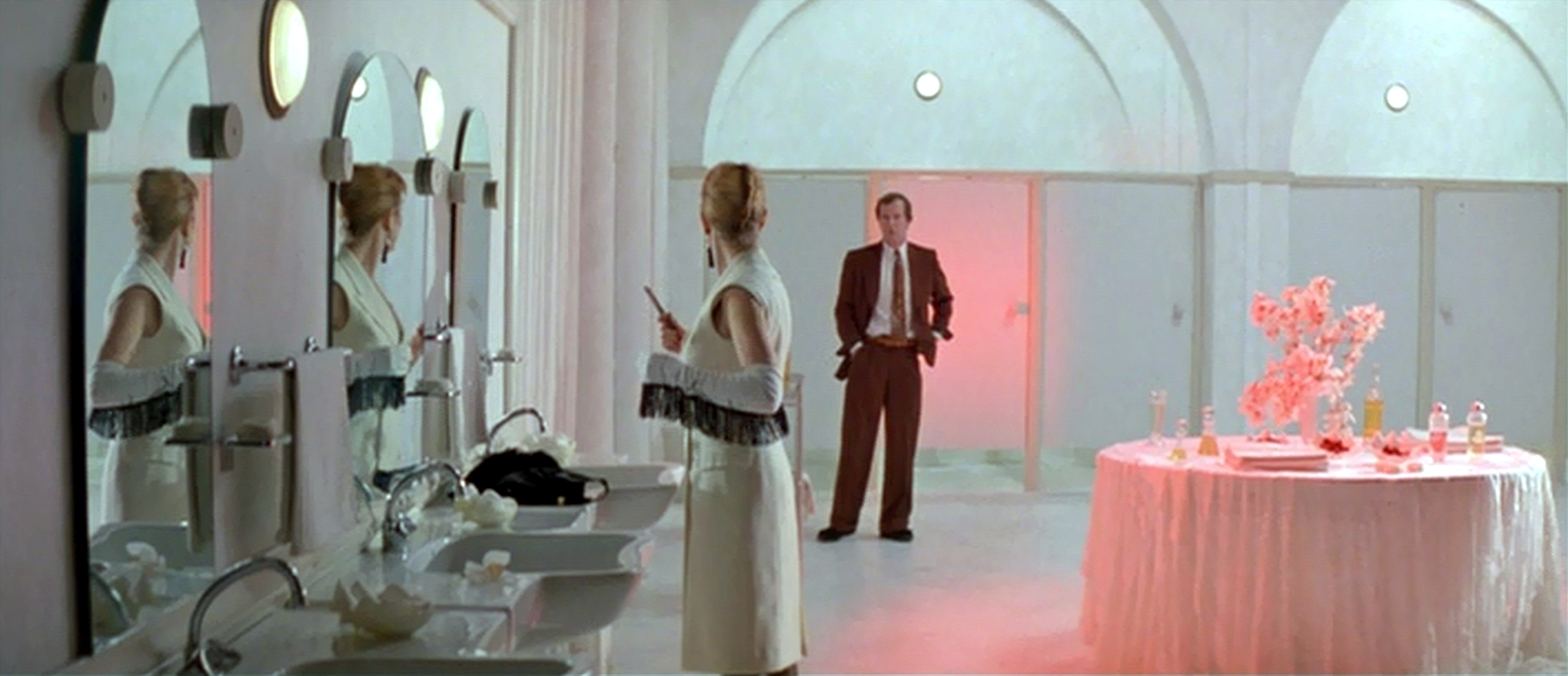
- The white bathrooms are Georgina’s space and stand for the 20th century: modern, convenient, and vulgar.
The action shifts continually from one space to another, gliding back and forth in conspicuous tracking shots. The effect should remind us that history is not just a simple progression but rather a layering of accumulated influences. The Middle Ages, for example, did not go away with the Renaissance – much of their thinking and output remains in our present world. Peter Greenaway’s films often trace the origin of modernity back to the 17th century, a brutal time of colonial expansion and ferocious religious wars in Europe. It should not be a stretch to find the horrors of our present age rooted in that century’s violence, and the blood red dining room, the film’s nucleus, which mirrors the Frans Hals painting so closely, captures the persistent flavor of that violence.
Just as the locations reflect eras of history, the characters correspond to major sectors of society. The cook represents art; the thief (Albert Spica) stands for commerce; and the lover (Michael) is an intellectual. Spica’s wife Georgina is like the British public – trapped in an unpleasant marriage with commerce, in love with the intellectual, and consuming the works of artists. Religion, represented by the nuns in the hospital, plays a background role as it does in modern life. Amid all these allegorical connections the film keeps hinting at the one major sector that is so egregiously absent. Government is barely evident, represented only by the inconsequential health inspectors who examine the trucks outside, who never speak a line and are reputedly in Albert’s pocket anyway. Anyone watching must surely wonder at some point why none of Albert’s victims seeks recourse in the police, but the horror of this film – and of Thatcher’s right-wing libertarianism, taken to its logical conclusion – is that the rule of law takes a back seat to the power of commerce. An accountable democratic government should be able to function without tyranny, yet when politicians like Thatcher and Reagan rile people against every form of government, deregulating business and privatizing everything they can in the name of “freedom”, they open a power vacuum that private business interests like Albert Spica are happy to fill.
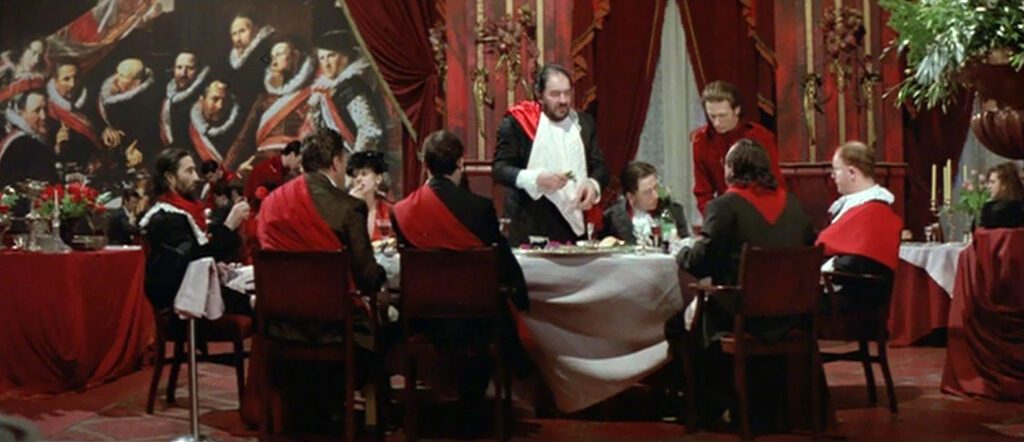
Actually the health inspectors are not quite the only tokens of government. In the opening scene Albert’s men smear dog feces and urinate on an allegedly delinquent debtor named Roy. The name “Roy” derives from the French word for “king”, making Albert’s treatment of the man all the more shocking to a British audience. The idea is that despots of commerce have not only usurped the monarch’s power but also inflict grievous insult on the once sacred traditions associated with the rule of law. Apart from all the filth, the idea of treating a king like a debtor is unthinkable in England. One doesn’t have to be a royalist to appreciate the repugnance of Albert’s alternative to royal power. It’s like the Reign of Terror in the French Revolution, so clearly alluded to when Michael’s dead body appears amid the pages of his favorite book with the word “Terror” in the foreground.
The movie begins with dogs fighting over scraps of meat, a picture of violence driven by consumption. From there until Albert’s bite of human flesh at the end, food and excrement will always be a metaphor for consumption in a broader economic sense. Albert’s power comes from food, and he uses it as a weapon: dog waste on Roy, a bowl of soup over a customer’s head, a fork in Patricia’s cheek, force-feeding pages to Michael and buttons to Pup. In the same way, unchecked commercialism turns every part of life, even ideas, into objects of consumption. Besides Albert’s thuggery, his defining trait is his lack of taste. He cannot appreciate food, singing, women, or anything else on its own merits. He values prairie oysters for their obscenity, he likes seafood because it appealed to tyrants like Hitler, he pronounces “poisson” as “poison”, and he smothers his food in salt. He cheapens everything he touches, like so much of modern commerce. It may be hard to watch the movie today without thinking how closely Albert predicted the behavior, manners, and values of a certain American president whose policies descended from Reagan’s, but it shouldn’t be surprising. That same president was already famous in Reagan’s time as a poster child for unfettered consumption.
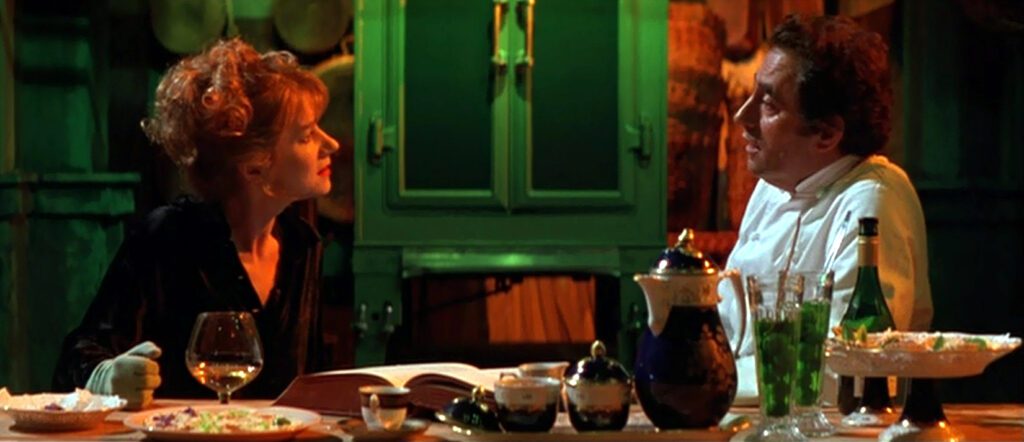
As the embodiment of the intellectual, Michael is ineffectual in a world ruled by commerce. He says nothing until invited to Albert’s table, where the little boldness he displays makes no difference. The movie puts greater hope in the artist – Richard always speaks his mind to Albert, offers refuge to Georgina and Michael, aids the abused, and finally, when allied with the public (Georgina), helps to bring down the tyrant.
The Frans Hals painting has a double significance beyond its role as an emblem of the 17th century. The original was a variation on the Last Supper with thirteen figures around a long table, and at Albert’s table, which conspicuously echoes the painting, Albert occupies the place of Christ. Like the abuse of Roy, this is meant to drive home the perversity of elevating commerce above everything else. Secondly, the painting is explicitly set in 1616, the year Shakespeare died, and in that sense it also evokes the death of British culture.
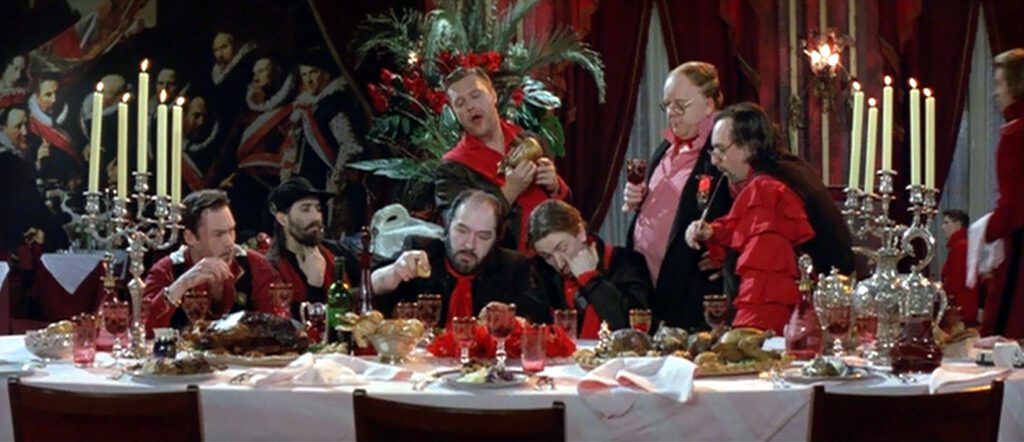
The ending is hard to forget, especially the image of Michael’s naked body roasted, glazed, and garnished like meat at a banquet. When Georgina, backed up by the cook and the kitchen staff, forces Albert to take a bite, it plays like a Jacobean revenge play – yet the film does not quite revel in the revenge. For all its shock value it’s easy to overlook how restrained the ending is. Georgina allows Albert to fortify himself with a couple glasses of wine; she doesn’t insist when he bypasses her instruction to “try the cock”; and she gives him a quick death after just one bite. The movie’s point is not to punish him but to expose beyond doubt what we should already have known, that he’s a coward and a cannibal.
CONNECTIONS:
Modern Times – Food as an economic metaphor
Phone Call from a Stranger – Symbolic division of society into four sectors: law/government, commerce, art, & science/intellect, with religion thrown into the mix
Fires on the Plain – Cannibalism as a metaphor for cutthroat capitalism
Last Year at Marienbad – Curtains at the end (or also beginning) to signal theatricality
The Servant – Stages of past history persisting as layers in the present
Seconds – Dystopia ruled by private enterprise in the virtual absence of government
Cries and Whispers – Large red room that evokes an idea of blood
The Hypothesis of the Stolen Painting – Series of spaces that represent distinct eras and centuries
Blade Runner – Dystopia ruled by private enterprise in the virtual absence of government
Blue Velvet – Study of a vulgar man-child (psychological focus in the Lynch film, socio-political in the Greenaway)
Raise the Red Lantern – Structured in distinct parts along axes of time, place, and character; abundance of symmetry
Breaking the Waves – Co-existence of the 17th and 20th centuries and the unexpected accord between them
Matchstick Men – Character named “Roy” who alludes to royalty